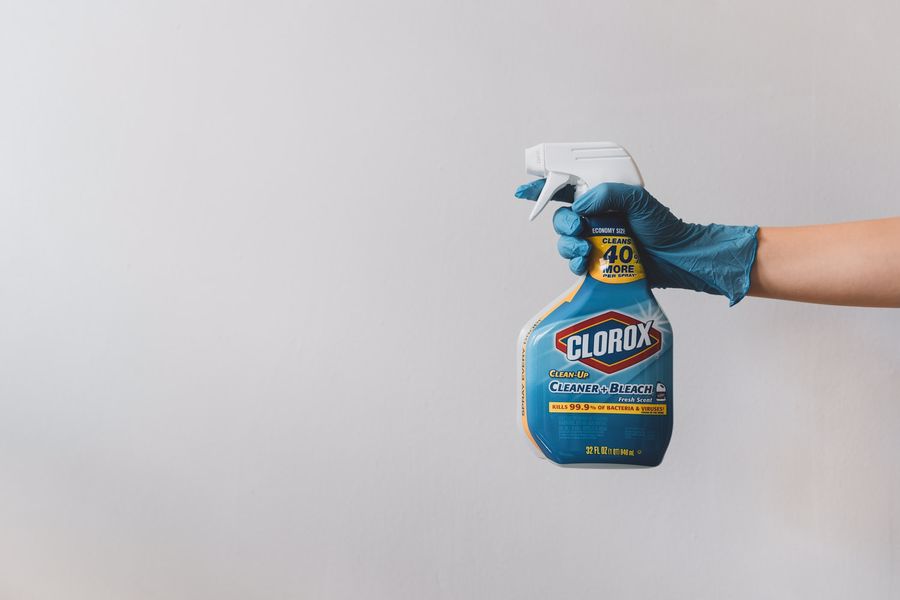As an Amazon Associate we earn from qualifying purchases.
Who doesn’t love a freshly brewed cup of coffee? But imagine a dirty coffee maker. Unfortunately, coffee makers are often one of the most contaminated items in a kitchen because they are both damp and warm, the ideal conditions for bacterial growth. But the good news is that cleaning a coffee maker isn’t that difficult after all.
So, let’s see how to clean a coffee maker with bleach.
Contents
How To Clean A Coffee Maker With Bleach
Although using bleach to clean a coffee maker may seem like a bad idea, it is possible if you follow the proper guidelines. As you may know, bleach is often used for industrial purposes, so you need to be careful and precautious during the entire process to ensure you leave no residue in the brewer.

Items Required
- A tablespoon
- Some amount of bleach
- Large amounts of water
Step 1: Prepare A Solution Of Bleach And Water
Bleach has a strong and corrosive nature, and hence it should never be directly applied on the surface of your the materials you are cleaning like faux wooden blinds, tile countertops and coffee makers.
- Add one tablespoon of bleach into a gallon of water. Adding larger amounts can cause the solution to corrode the coffee maker.
- Make sure that you add the bleach into the water only in a place that is well ventilated like your outdoor decking.
- Fume or vapors released during the process may cause breathing problems and choke the people around. You should be careful while mixing the two.
Step 2: Run A Complete Cycle Of The Coffee Maker
Once you have prepared the solution required for cleaning, you are ready to clean the coffee maker.
- Fill the water reservoir of the coffee maker with the bleach solution. Make sure to fill it up to the brim to ensure complete cleansing.
- Fill the coffee pot with the solution, and then allow the solution to run entirely through the maker.
- This ensures any foreign material sticking to the surface of the maker gets effectively removed.
Step 3: Pour The Water Out Of The Pot
After you have run the bleach solution through the coffee maker, it will accumulate some dirt on the coffee maker’s surface.
- As soon as the coffee pot is filled up, turn off the coffee maker and pour out the solution used for cleaning.
- Turning off the coffee maker at the right term is imperative because the bleach solution adds to the heat generated by the coffee maker and can cause overheating, which may lead to damage to the coffee maker.
- Also, ensure a minimum amount of bleach solution comes in contact with the heating plates of the coffee maker.
Step 4: Repeat The Process
At the beginning of the cleaning process, you prepared a solution using a gallon of water with a tablespoon of bleach.

The excess solution shouldn’t be thrown away but instead used again for effective cleaning.
- Running the solution through the coffee maker just once might not be enough to get the cleaning done.
- Repeatedly run the remaining solution through the coffee maker. Take care to turn off the coffee maker at the correct time to avoid excessive heating.
Stay beside the coffee maker during the complete cleaning process. If anyone accidentally uses the machine without knowing that you are applying bleach for cleansing, he/she might seriously fall ill.
Step 5: Clean The Coffee Maker With Hot Water
Once you have used up the entire solution to clean the coffee maker, you need to ensure that no trace amount of bleach is left over in the coffee maker.
- To ensure this, you need to wash the coffee maker with gallons of water. It is highly advisable to use warm water.
- Heating such large volumes of water may be a time-consuming process. You may choose to pour some water at room temperature into the coffee maker and turn it on.
- Since any residual amount of bleach remaining inside the coffee maker can cause serious health hazards, you must pass at least five gallons of water through the coffee maker.
- After running the fifth gallon of water through the coffee maker, smell the water you throw out. If you get the unique smell of chlorine from the water thrown out, pass more water through.
Once this smell vanishes, you can move to the next step. If you want to take some extra precautions, you can check the pH of the water in it. The ideal pH of water is 7.
You can also use blue litmus paper, and if it doesn’t turn red, the water is no longer acidic.
Step 6: Air Dry The Coffee Maker
Once you have passed enough water through the coffee maker to clear out all the bleach, it is necessary to dry it properly.
- Turn the coffee maker upside down and dry it under bright sunshine for an entire day, like your concrete surface. It is essential to remove even trace amounts of moisture.
- If you can’t place it under sunshine, dry it inside your room for at least a week. This drying causes any trace amount of bleach remaining inside the maker to solidify and fall off.
- If you see this, you will need to run some more water through the coffee maker to remove the bleach.
This video on how to clean a coffee maker without using vinegar will give you more alternative processes that can be used for cleaning.

Alternatives For Cleaning A Coffee Maker
While bleach is an excellent cleansing agent, it is not recommended to use unless necessary. Thus, it is handy to be aware of some alternative ways of cleaning.
You must try to prevent the coffee maker from getting dirty as much as possible. You can do this by drying the reservoir after every time you brew the coffee.
To clean using alternative methods, you can make a solution with one tablespoon of vinegar, salt, and water. This is actually use for cleaning nut milk bags as well. Then repeat all other processes.
Although this solution is not as effective as bleach, it is a much safer and easier thing to use. This article has more information on the health hazards of bleach.
Frequently Asked Questions
Is It Safe To Use Undiluted Bleach For Cleaning A Coffee Maker?
Undiluted bleach should not be used to clean a coffee maker at any cost. It can cause severe health issued if consumed. Instead, you should use a very dilute bleach solution for cleansing to be removed entirely at the cleaning end. The removal of bleach is very important for the cleaning process.
How Often Should A Coffee Maker Be Cleaned?
The frequency of cleaning required to maintain your coffee maker in good condition depends on the kind of water you have at your home. If the water is soft with very low sediment content, you might need to clean it in six months. If there is hard water, you may need to clean the coffee maker once a month.
Conclusion
A coffee maker that is not clean can cause health issues to people using it. Cleaning it using bleach is effective but also requires proper care. If you are going to use bleach, make sure you use a properly diluted solution and dry it properly after cleaning.
Use the coffee maker only when the slightest amount of bleach is removed.
